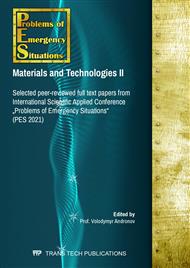[1]
G. Brancatelli, C. Colleoni, M.R. Massafra, G. Rosace, Effect of hybrid phosphorus-doped silica thin films produced by sol-gel method on the thermal behavior of cotton fabrics, Polymer Degradation and Stability. 96 (4) (2011) 483–490.
DOI: 10.1016/j.polymdegradstab.2011.01.013
Google Scholar
[2]
B.J.J. Zelinski, D.R. Uhlmann, Gel technology in ceramics, J. Phys. and Chem. Solids. 45 (10) (1984) 1069-1090.
DOI: 10.1016/0022-3697(84)90049-0
Google Scholar
[3]
S. Sakka, Sol–gel science and technology. Topics and fundamental research and applications. Kluwer Academic Publishers, Norwell, (2003).
Google Scholar
[4]
Y.N. Goncharenko, O.B. Skorodumova, D.S. Pushkar', G.D. Semchenko, Preparation of silica fillers for stomatologic composite materials, Refractories and Industrial Ceramics. 42 (9–10) (2001) 307–309.
DOI: 10.1023/a:1014069109343
Google Scholar
[5]
C.L. Chiang, R.C. Chang, Synthesis, characterization and properties of novel self-extinguish organic-inorganic nanocomposites containing nitrogen, silicon and phosphorus via sol–gel method, Composites Science and Technology. 68 (14) (2008) 2849–2857.
DOI: 10.1016/j.compscitech.2007.10.017
Google Scholar
[6]
C.L. Chiang C.C.M. Ma, D.L. Wu, H.C. Kuan, Preparation, characterization and properties of novolac-type phenolic/SiO2 hybrid organic-inorganic nanocomposite materials by sol–gel method, Journal of Polymer Science Part A: Polymer Chemistry. 41 (7) (2003) 905–9 13.
DOI: 10.1002/pola.10624
Google Scholar
[7]
C.L. Chiang, S.L. Chiu, Synthesis, characterization and properties of halogen-free flame retardant PMMA nanocomposites containing nitrogen/silicon prepared from the sol–gel method, Journal of Polymer Research. 16(6) (2009) 637–646.
DOI: 10.1007/s10965-009-9268-9
Google Scholar
[8]
B. Mahltig, H. Buttcher, H. Rauch, U. Dieckman, R. Nitsche, T. Fritz, Optimized UV protecting coatings by combination of organic and inorganic UV absorbers, Thin Solid Films. 48 (1–2) (2005) 108–114.
DOI: 10.1016/j.tsf.2005.03.056
Google Scholar
[9]
F.Y. Li, Y.J. Xing, X. Ding, Y. Zu, Immobilization of papa in on cotton fabric by sol–gel method, Enzyme and Microbial Technology. 40 (7) (2007) 1692–1697.
DOI: 10.1016/j.enzmictec.2006.09.007
Google Scholar
[10]
A.R. Horrocks, High Performance Textiles and their Applications, Woodhead Publishing Series in Textiles, (2014).
Google Scholar
[11]
A.C. Cireli, N. Onar, M.F. Ebeoglugil, I. Kayatekin, N. Kutlu, O. Culha, E. Celik Development of flame retardancy properties of new halogen-free phosphorous doped SiO2 thin films on fabrics, Journal of Applied Polymer Science. 105 (6) (2007) 3747–3756.
DOI: 10.1002/app.26442
Google Scholar
[12]
S. Hribernik, M.S. Smole, K.S. Kleinschek, M. Bele, J. Jamink, M. Gaberscek Flame retardant of SiO2-coated regenerated cellulose fibres, Polymer Degradation and Stability. 92 (11) (2007) 1957–(1965).
DOI: 10.1016/j.polymdegradstab.2007.08.010
Google Scholar
[13]
N. Yaman, Preparation and flammability properties of hybrid materials containing phosphorous compounds via sol–gel process, Fibers and Polymers. 10 (4) (2009) 413–418.
DOI: 10.1007/s12221-009-0413-1
Google Scholar
[14]
J. Alongi, M. Ciobanu, G. Malucelli, Cotton fabrics treated with hybrid organic–inorganic coatings obtained through dual-cure processes, Cellulose. 18 (2011) 1335–1348.
DOI: 10.1007/s10570-011-9564-5
Google Scholar
[15]
J. Tata, J. Alongi, F. Carosio, A. Frache, Optimization of the procedure to burn textile fabrics by cone calorimeter: part I. Combustion behavior of polyester, Fire and Materials. 35 (2011) 397–409.
DOI: 10.1002/fam.1061
Google Scholar
[16]
J. Alongi, M. Ciobanu, G. Malucelli, Sol–gel treatments on cotton fabrics for improving thermal and flame stability: effect of the structure of the alkoxysilane precursor, Carbohydrate Polymers. 87 (1) (2012) 627– 635.
DOI: 10.1016/j.carbpol.2011.08.036
Google Scholar
[17]
J. Alongi, M. Ciobanu, G. Malucelli, Thermal stability, flame retardancy and mechanical properties of cotton fabrics treated with inorganic coatings synthesized through sol–gel processes, Carbohydrate Polymers. 87(3) (2012) 2093–(2099).
DOI: 10.1016/j.carbpol.2011.10.032
Google Scholar
[18]
O. Skorodumova, O. Tarakhno, O. Chebotaryova, Y. Hapon, F.M. Emen, Formation of fire retardant properties in elastic silica coatings for textile materials, Materials Science Forum. 1006 (2020) 25–31.
DOI: 10.4028/www.scientific.net/msf.1006.25
Google Scholar
[19]
O.B. Skorodumova, G.D. Semchenko, Y.N. Goncharenko, V.S. Tolstoi, Crystallization of SiO2 from ethylsilicate-based gels, Glass and Ceramics (English translation of Steklo i Keramika). 58 (1-2) (2001) 31–33.
DOI: 10.1023/a:1010933028152
Google Scholar
[20]
O. Skorodumova, O. Tarakhno, O. Chebotaryova, M. Skripnik, The use of organosilicon raw materials of a technical level of purity to obtain binary protective coatings on fabric in the SiO2 sol – flame retardant system, Fire safety problems. 47 (2020) 112–119.
Google Scholar


